When I first saw the NETGEAR 3DHD product on the showroom floor of CES, there was the device sitting on the table and a video playing on a screen. I was confused as to the nature of the device; was it a wireless HDMI solution? The product model is 3DHD, with 3D, HD 1080p, video, etc. plastered all over the packaging, and the product name is 3DHD Wireless Home Theatre Networking Kit. As we spoke with a Netgear representative, it became clear that this was not a wireless HDMI implementation but an 802.11 networking solution. To put it in clear terms, despite the 3D buzzwords plastered all over the box, to the technical user; this product is a network bridge device.
NETGEAR isn't wrong to focus some of their 802.11 products directly at multimedia applications, as moving video wirelessly and reliably to high definition TV sets is a feature that many people are looking for. For cost, ease of use, and superior reliability, it is always recommended to simply run a cable. Sometimes however, a wireless solution is the only answer. Maybe you rent and your landlord doesn't want any holes punched in the walls, or maybe there is more complexity and cost in getting the wiring in the wall or across the house than by simply using a wireless solution.
NETGEAR's whitepaper documentation identifies bandwidth and interference as the two major challenges to getting reliable, bandwidth intensive video applications to work properly over wireless. To get the required amount of bandwidth, the 3DHD utilizes 4x4 MIMO antenna technology. MIMO systems offer significant increases in data rates, range, and reliability by exploiting the spatial dimension associated with the multiple antennas. The 4x4 MIMO configuration provides two extra transmit antennas for beamforming, which allows significant focusing of the energy in two directions. This is done to improve reliability as well as to reduce interference with existing wireless systems, steering the energy directly in the required direction. We are eager to see if the technical features built into this product provide any advantage over other 5GHz networking devices.
NETGEAR officially lists this product on its website under the Home Theatre section, which may seem strange for a networking device that is in reality a TCP/IP 802.11x device. However, looking at the packaging reinforces the marketing decision that NETGEAR has made.
The NETGEAR 3DHD kit comes with a pair of WNHD3004 devices. Tthese two units come paired from the factory to work with each other out of the box. Additional WNHD3004 devices can be added to the networking configuration as needed.
The kit (WNHDB3004) includes:
- 2x Networking Units (WNHD3004)
- 2x AC Power adapters
- 2x 6' Ethernet cables
- 1 Instruction Guide
- 2x Detachable Stands
Since the two adapters in the kit come paired from the factory, there is very little configuration required; the devices worked plug and play. Connect one unit to your existing router or switch, and the other to your devices at the remote location. If desired the devices can be changed from the AUTO setting to specifically declare the device the access point or the bridge device. The units have reset buttons and also include switches for turning the device on and off.
The front of the device is simplistic. It features one WPS button, for when the device is acting as the access point, and two indicator LEDs. One shows that the device has power, and another gives the user some sort of indication of connectivity. Green means the connection exists and is fast, orange for average connectivity, and red for a slow or nonexistent connection.
The device does not make use of gigabit ethernet ports; wireless speeds very rarely exceed 100Mbps, so the addition of gigabit ports would only be useful for the communication of devices between each other on the other side of the bridge. Most users would not need to make use of the higher speeds gigabit support would provide in this very specific configuration, and NETGEAR has opted to keep costs down by utilizing 100Mbps ports.
Testing Locations:
Location 1: 5 feet apart "open air"
Devices are placed next to each other without any obstacles at a range of five feet representative of a best-case scenario.
Devices are placed next to each other without any obstacles at a range of five feet representative of a best-case scenario.
Location 2: One room apart
Devices are placed in separate rooms 15 feet apart from each other with obstacles including heating vents, electrical outlets and standard U.S. plywood / sheetrock based walls. Representative of an average usage scenario.
Devices are placed in separate rooms 15 feet apart from each other with obstacles including heating vents, electrical outlets and standard U.S. plywood / sheetrock based walls. Representative of an average usage scenario.
Location 3: One house apart
Devices are placed roughly 75 feet apart on different ends of different floors of a two story house, direct obstacles include a furnace, two bathrooms, and two additional rooms. Representing a worst case scenario in a common household.
Devices are placed roughly 75 feet apart on different ends of different floors of a two story house, direct obstacles include a furnace, two bathrooms, and two additional rooms. Representing a worst case scenario in a common household.
Comparative Testing:
For comparative testing, we used other networking devices that would give interesting comparisons to the NETGEAR 3DHD based on the following criteria:
A) The Device operates on the 5GHz spectrum.
B) The Device is configured to use the same type of encryption [WPA2 AES+TKIP]
Device Pairs Used in Testing:
NETGEAR 3DHD KIT [NETGEAR WNHD3004 -> NETGEAR WNHD3004]:
The pair of devices being reviewed.
LINKSYS WRT610N V2 -> LINKSYS WUSB600N
The LINKSYS WRT610N V2 is a high speed dual band router capable of operating on both the 2.4GHz and 5GHz spectrum at the same time; we pair it with LINKSYS' 5GHz USB adapter.
LINKSYS WRT610N V2 -> LINKSYS WGA600N
The WGA600N is also marketed as a bridge device, specifically a dual band wireless gaming adapter. Like the 3DHD kit, it takes a wireless signal and adapts it for use with wired devices.
Testing Software:
Ixia IxChariot 7.10 SP3
We used Ixia IxChariot Endpoint Platform Software for Microsoft Windows Vista / Windows 7 / Windows Server 2008 R2 / Windows Server 2008 – x86 / 64-Bit 7.10 SP3 to collect transmission speed results.
Location 1 Testing:
Here at the 5 feet optimal range testing, we see that all these adapters are performing extremely well. The NETGEAR falls behind the other offerings at this close range; however, it appears like NETGEAR's maximum throughput rate may possibly be limited in order to improve reliability (note the 72.728Mbps max that is prevailant throughout all the tests.)
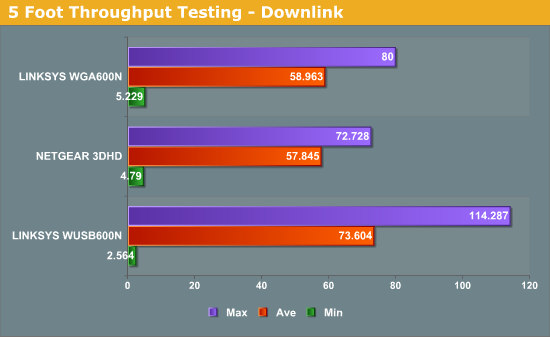
Location 2 Testing:
We actually see both the 3DHD and the WUSB600N adapters improve their speeds in the other room; it appears that the adapters we are using don't like being as close together as 5 feet. However we do see the WGA600N sart to lose some throughput.

Location 3 Testing:
Things really get shaken up here at the whole house testing. The NETGEAR 3DHD kit is barely taking a hit in performance at this range. Keep in mind that this is real world testing on opposite ends and differing floors of a 2500 square foot house. Here we see that both the other 5GHz adapters are only working at 38% and 64% of their one room apart testing, and the 3DHD is almost doubling their average throughput.
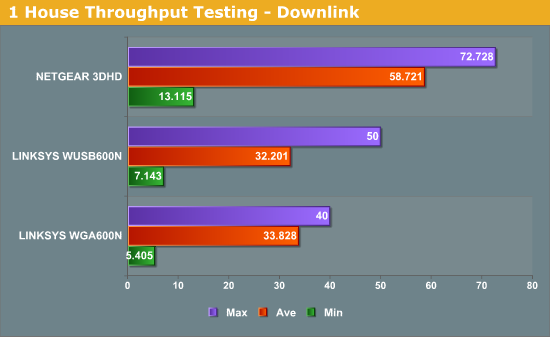
Location 1:
Here we see similar results to our downlink testing, with the WUSB600N really laying on the speed at close ranges and the 3DHD keeping its very consistent throughput numbers up.
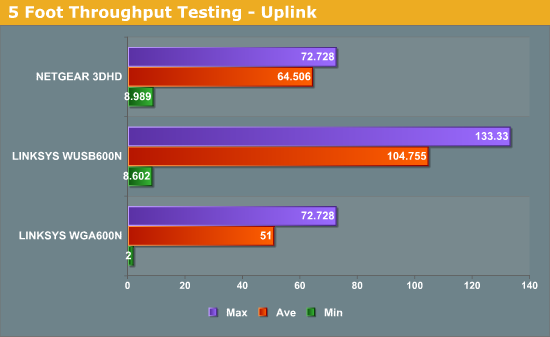
Location 2:
Once again, the 3DHD isn't topping the throughput charts but provides very adequate performance.
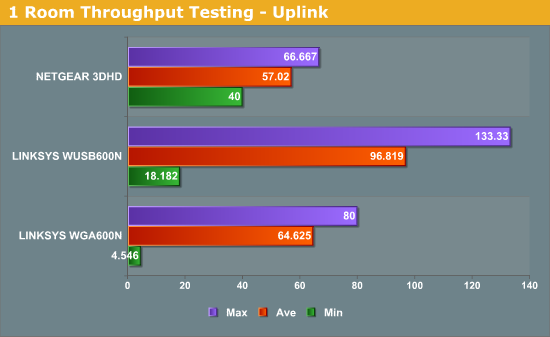
Location 3:
The NETGEAR 3DHD shows real promise compared to other adapters at long distances with more obstacles. Here at the one house range it shows no signs of slowing while the other devices are being affected by the distance and obstacles in the way of the adapters.
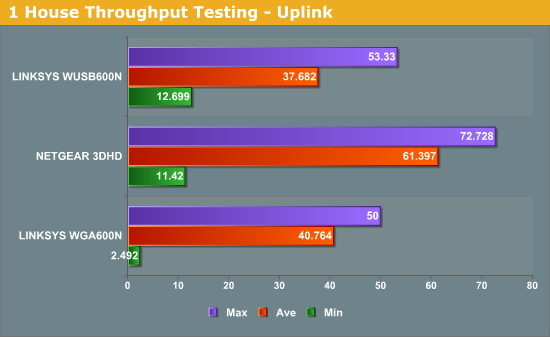
To give some idea of the throughput consistency offered by this device, here are some graphs showing the throughput levels at location 3.
We see that the netgear device really has some tight throughput even at the most distant location. While the signal isn't completely dropout free, it is pretty impressive. It really demonstrates that the NETGEAR adapters' real strength is its ability to provide consistent throughput, rather than topping the charts in raw speed. This is especially important for video applications, since droupouts and widely varying throughput speeds can cause stuttering and choppy video issues.
Real World File Copy Testing:
While IxChariot is good for measuring some characteristics of performance, we also performed some additional tests. First, a series of files totaling 6GB was transferred and timed over each of the device pairs. The numbers here reflect real world data transfers. We skipped the "ideal" 5 feet scenario this time as that didn't seem to be very important.
The interesting thing is that even though the Ixia Endpoint testing showed the WUSB600N performing much faster during the theoretical benchmark tests, here in the file copy test it only just outperforms the 3DHD device. Both of the leading devices at the one room testing range are transfering data at what equates to 83 Mbps. At location three, full house testing, we see some clear results. While the NETGEAR 3DHD pair is boasting around 69 Mbps, the other two devices have slowed to 32 Mbps.
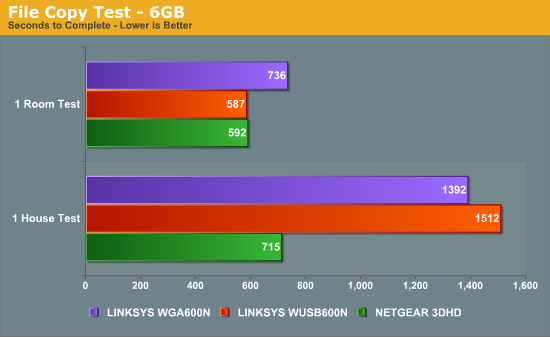
5GHz Coexistence:
NETGEAR is marketing the 3DHD as a solution that can be added to existing wireless networks. Since the majority of wireless networks are based on the 2.4GHz range and this device operates on the 5GHz spectrum, the NETGEAR devices should not impact the existing 2.4GHz network. However, some users are utilizing 5GHz wireless routers already. Testing was performed to see if the performance of the NETGEAR 3DHD was impacted when using other 5GHz network devices at the same time.

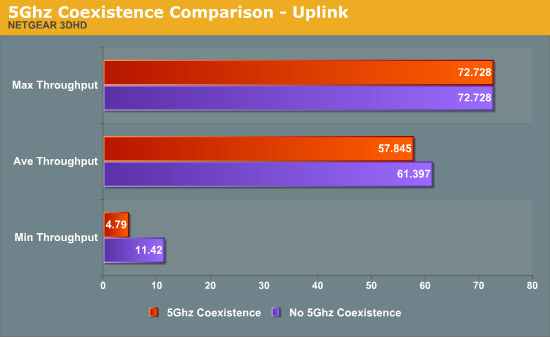
In both the downlink and uplink tests, comparing when other 5GHz devices are present and when they are not present, there is minimal variation. This minimal impact may be due in part to the spacial beamforming features of the 4x4 MIMO technology that NETGEAR has implemented.
1080p and Blu-ray Content Streaming:
So we have seen that the NETGEAR 3DHD Networking kit is capable of pushing some very consistent throughput numbers. However, NETGEAR has also marketed this device as being capable of streaming high quality content over the air. At the CES show booth NETGEAR was showing multiple video streams being played at the same time.
It was possible to duplicate this during testing: three instances of a 1080p copy of Big Buck Bunny were streamed wirelessly to three separate devices using NETGEAR's 3DHD solution (see image below). The playback had no frame droupout issues on any of the devices, and frankly it was impossible to distinguish that the files were being played over a wireless bridge and not via a standard wired LAN configuration in terms of responsiveness and load time.
Blu-ray Content:
It is one thing to play 1080p content that has been optimized for low file size and easy distribution and quite another to handle full quality Blu-ray content with streams as dense as 54Mbps (max data transfer rate for Blu-ray). Testing was performed playing fully featured Blu-ray content (including menus) via mounting ISOs in virtual clone drive.
At Locations one and two, the NETGEAR 3DHD pair was entirely capable of distributing Blu-ray content. After watching four separate Blu-ray titles over the device, I encoutnered only one instance during an exceptionally detailed and scene with a lot of movement where the video playback stuttered.
At location three, the worst-case scenario, skipping was more frequent during high detail scenes. However, in general the playback was acceptable, which is actually quite a feat considering that the two devices were at other sides of the house, and the fact that none of the other 5GHz devices could produce performance at that range that would be considered acceptable for any respectable amount of time.
Conclusion:
Retail pricing on this product is geared at the $300 price point, but it can be found for around $220 online if you shop around. The NETGEAR 3DHD is truly a niche product, and lots of variables will come into play in order for this device to be a good fit for a purchasing consumer. As we see it, there are three major points you need to satisfy:
- The consumer has a location where they would like connectivity that is away from standard connectivity options.
- The consumer is unable / unwilling to run Ethernet cabling.
- The consumer desires to stream high definition video.
Given those three points, there are still many options that exist as solutions that will fill this need. In some cases, a simple wireless USB adapter or similar device will suffice. Here are some advantages that the NETGEAR 3DHD has over such solutions.
Distance: The 3DHD kit is capable of providing quality throughput even 50 feet apart on other sides and different floors of a house. It was capable of almost double the bandwidth as our other comparative testing devices and was operating within 10% of its highest speed.
Connectivity Options: The 3DHD kit has four networking ports providing additional connectivity to those who may have not only an HTPC, but also an Internet Ready TV, gaming system, etc. The fact that this device will connect your device over a standard cable (rather than USB) also means that you will be able to utilize WOL options. This could be an important feature for those who like to configure devices to shutdown or sleep while still being able to initialize them remotely over LAN.
Ease of Use: Out of the box, the 3DHD kit was entirely plug and play. All the ports are auto-sensing, so you really don't have to know much about networking in order to get this device going. Just plug one unit into your router and the other into the device(s) that need connectivity. No drivers or configuration needed.
Signal Stability: The 3DHD kit provides very consistent throughput numbers, since the two devices are specifically designed, configured, and tested to work with each other well. The stability of the connection in our testing proved very reliable and consistent. One look at the throughput graph shows very tight throughput groupings. In terms of general stability, the pair has now been running for two weeks without slowing down or requiring a reboot.
Along with the good aspects and advantages, there are reasons for not adopting the 3DHD. Price is a major one; $220 isn't a small amount of money to spend, especially when a $30 dollar device may get you the same results Here are some other scenarios where the 3DHD might not be for you:
If the distance you need to bridge is very short. As we have seen, the NETGEAR 3DHD provided good throughput at close ranges, but was soundly beaten by other options at close range. If you are looking for absolute performance, the NETGEAR seems to cap out at 64Mbps (in IxChariot testing), while other devices performed as high as 84Mbps.
You already have a capable 2.4 / 5GHz Router: You can most likely get away with purchasing a single unit bridging device that will perform adequately, though you may still desire the 3DHD kit for its connectivity options and signal stability.
NETGEAR offers a highly capable product here. If you need a superior network bridging device, you may not need to look much further than the 3DHD. While a premium product comes with a premium price, it may well be worth it for those looking for a bridging solution, especially those who need to cover a lot of distance from their source network to their remote location. For those people, if they want to view high definition streams, the 3DHD may be their only option.

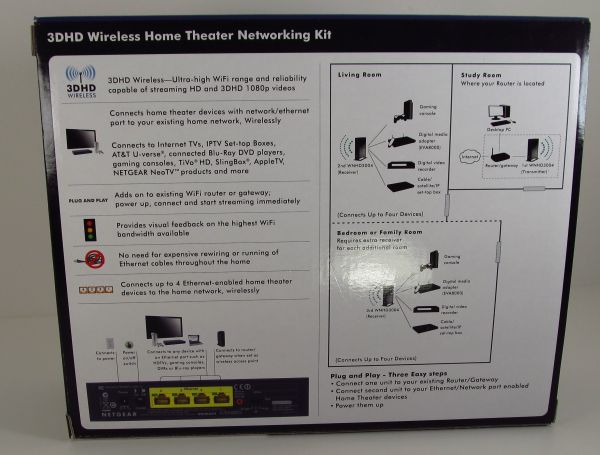
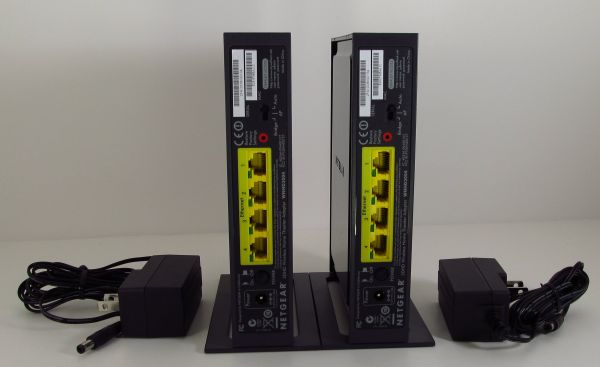



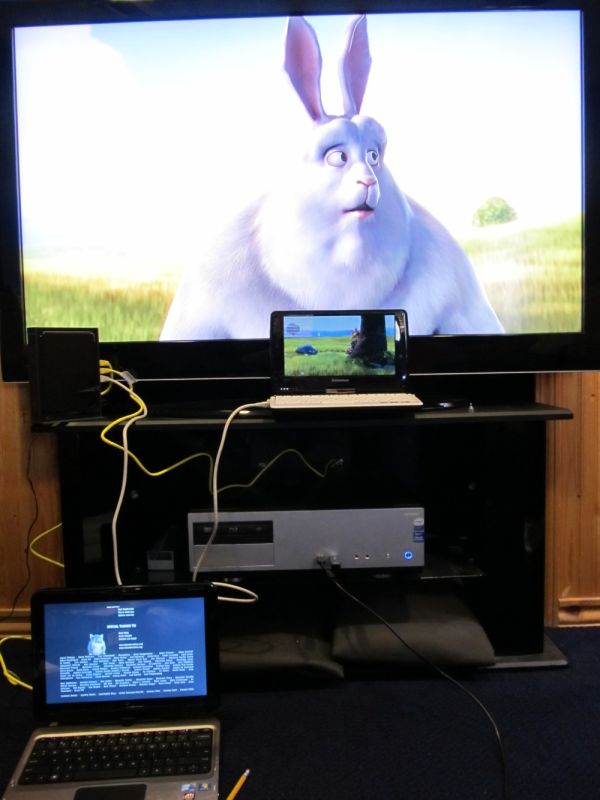
0 comments:
Post a Comment